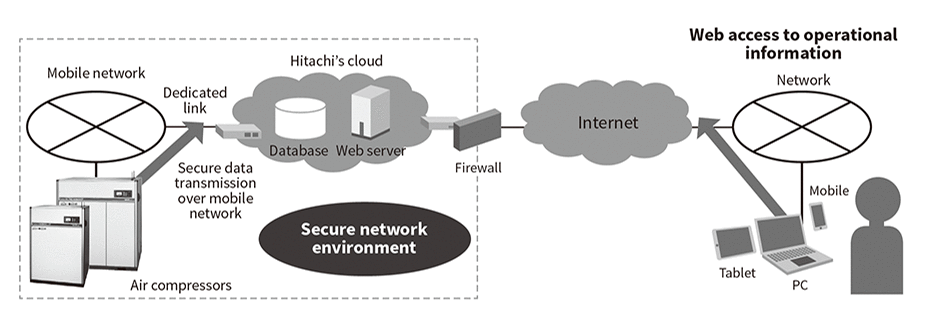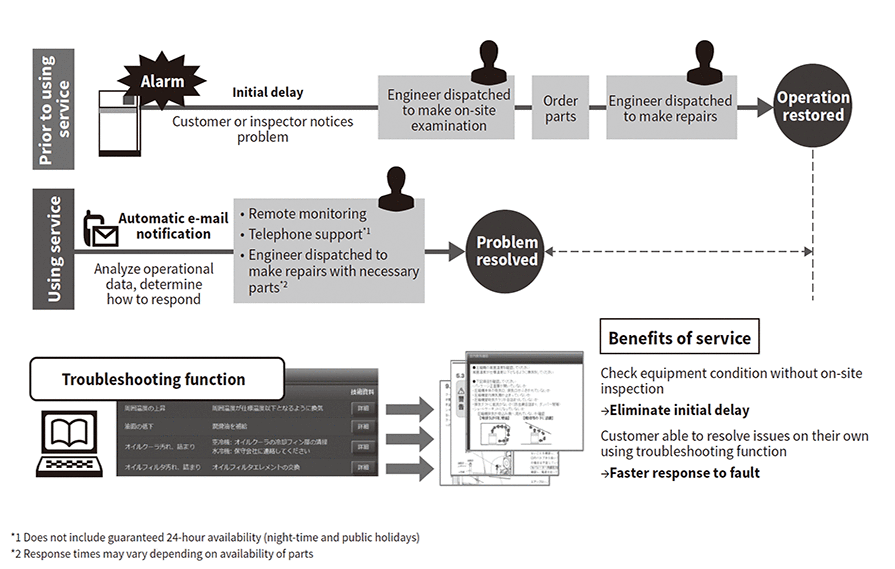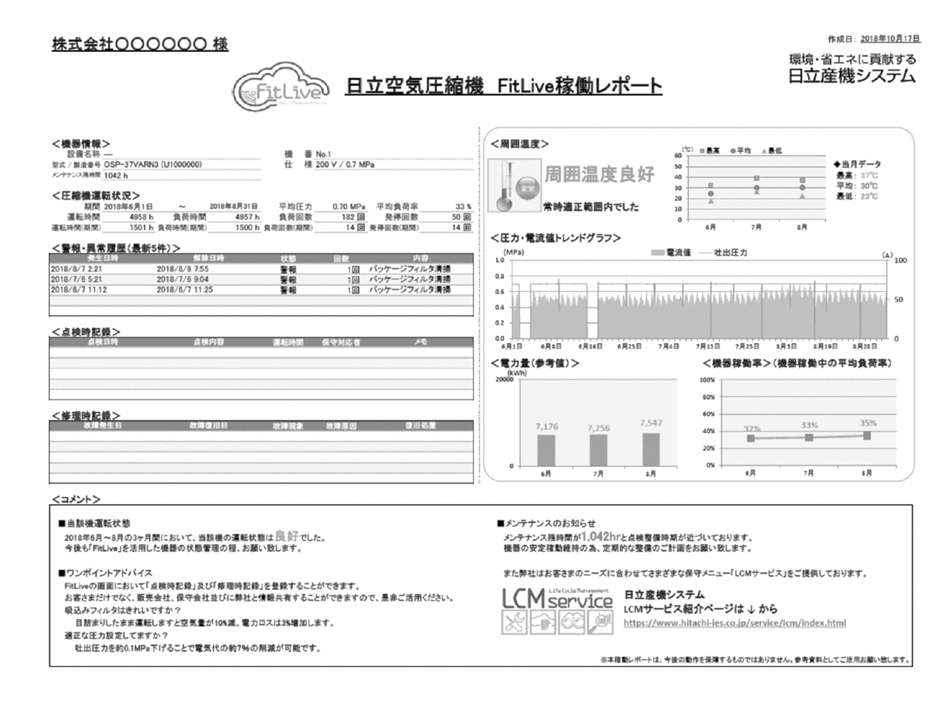OverviewRemote Monitoring Service to Support Optimal Operation of Air CompressorsServices, Systems, and Products for Smarter Factories
Highlight
Air compressors are widely used for purposes that include supplying air-driven equipment in production lines and are said to account for approximately 30% of power consumption at a typical manufacturing plant. As the use of air compressors varies depending on a factory’s production process, and because their efficient operation can reduce energy consumption, there is rising demand for remote monitoring to support efficient operation through appropriate maintenance. However, connecting such machinery to the network inside the factory requires installation work to be done and also raises challenges for cybersecurity. In response, Hitachi supplies a cloud-based monitoring service that uses secure communications over public mobile networks to provide a trouble-free way to collect and use data from equipment, also fitting network interface devices as a standard feature on its air compressors to simplify the process of adopting cloud-based monitoring.

1. Introduction
Hitachi Industrial Equipment Systems Co., Ltd.’s (Hitachi IES) work on solutions for the industrial Internet of Things (IoT) is based on two concepts of “products that connect themselves” and “products that connect other devices and equipment.” The objectives of these concepts are to promote smart connected products that can be remotely monitored using the IoT to support the steady and proper operation of products at customer sites, and to use connectable products for smart factories to promote digitalization in the company’s own manufacturing processes. The former is intended to help maintain product quality at customer manufacturing sites, while the latter is undertaken to improve the quality built into customers’ manufacturing processes. Both seek to improve reliability (quality over time) across the entire product lifecycle.
With regard to smart connected products, this article describes a cloud-based monitoring service called “FitLive” in Japan that uses the IoT for the cloud-based monitoring of air compressors. Use of this cloud-based monitoring service provides continuous information on the condition of equipment via the Internet without the need for workers to visit the site in person. By establishing an ecosystem that goes beyond the vendor to extend from sales companies and maintenance providers to end users, it also provides the means for oversight by everyone involved. After first operating on a trial basis for approximately a year and a half using communication boxes installed on existing customer equipment, the cloud-based monitoring service has now been available since December 2017 when products with communications included as a standard feature first went on sale. The service was also among the first use cases to be added to Lumada, delivering new value through the use of equipment monitoring for reliable operation and to optimize maintenance costs.
2. System Configuration
2.1 Air Compressor Product Range
Industrial air compressors are widely used as a source of the compressed air used to drive manufacturing equipment and machinery. With the power they consume said to account for around 30% of the total at a typical manufacturing facility, electricity forms a large part of their lifecycle cost (LCC).
As air compressors are put to a wide range of uses, a variety of types and capacities are needed to suit different purposes. Along with the need for clean compressed air in food and pharmaceutical applications, for example, there are also applications requiring distributed installation where air compressors are located close to the equipment they serve, and different equipment requires different amounts of compressed air to run. Hitachi IES’s IoT-compatible rotary screw air compressors are available in a wide range of models to suit applications that vary widely between customers, from 19 to 200 kW in the case of oil-flooded air compressors and 15 to 770 kW in the case of the oil-free air compressors that deliver clean compressed air.
2.2 Simple and Secure Network Configuration
In the past, the remote monitoring of air compressors has required the fitting of special communication devices or network installation work. Other measures such as for cybersecurity needed when connecting to the cloud have also been an obstacle to its adoption. Hitachi IES’s IoT-compatible rotary screw air compressors, however, are provided with a secure network environment because they connect to the company’s cloud via the same public mobile networks as mobile phones where security is enforced by the network operator. This enables secure cloud monitoring to be configured easily without the need for any preparatory or installation work because the air compressors are supplied with mobile network interface devices and antennas already installed. A key feature of these “smart connected” air compressors is that, to ensure security, they do not connect directly to the Internet (see Figure 1).
Fig. 1—Remote Monitoring Using Cloud-based Monitoring Service Instead of the Internet, the cloud-based monitoring system used to provide the service uses highly secure mobile networks to send data to the cloud via dedicated links. The data is stored in a cloud established specifically for remote monitoring and is protected by firewall against unauthorized access from the Internet.
Instead of the Internet, the cloud-based monitoring system used to provide the service uses highly secure mobile networks to send data to the cloud via dedicated links. The data is stored in a cloud established specifically for remote monitoring and is protected by firewall against unauthorized access from the Internet.
2.3 Features of IoT-compatible Rotary Screw Air Compressors
Equipping an air compressor with a special communication device typically involves a complex communication environment setup involving cloud service configuration and installation of the link between machine and device, sometimes requiring the on-site installation of communication systems. In contrast, IoT-compatible rotary screw air compressors do not require any additional onsite installation because they are delivered from the factory with communication functions pre-installed (see Figure 2). Instead, communications and other settings can be specified via a simple and intuitive interface using the color touch screen on the compressor when it is powered up at the site (see Figure 3). Hitachi IES also makes cloud monitoring simple to get up and running, contract included, by handling all of the administration associated with maintenance services and the contract with the mobile network.
Fig. 2—IoT-compatible Rotary Screw Air Compressors The photographs show an oil-flooded screw compressor (left) and an oil-free screw compressor (right).
The photographs show an oil-flooded screw compressor (left) and an oil-free screw compressor (right).
Fig. 3—Touch Panel Screens on Air Compressor The screen on the left shows the communication status using automatic detection of the signal strength from the antenna and the screen on the right is a user consent form that prompts the customer to select whether or not they agree to the contract terms. A screen showing equipment owner details is among the other screens available.
The screen on the left shows the communication status using automatic detection of the signal strength from the antenna and the screen on the right is a user consent form that prompts the customer to select whether or not they agree to the contract terms. A screen showing equipment owner details is among the other screens available.
3. Features and Example Application of Cloud-based Monitoring Service
Having commenced operation in December 2017, the cloud-based monitoring service for IoT-compatible rotary screw air compressors now has connections to more than 5,000 compressors (as of October 2019) and the number of companies adopting the service continues to steadily increase. The service is available with either a standard plan or a function-limited plan. The standard plan charges a fee and provides status monitoring, messaging, trend graphs, reports, and troubleshooting among its functions. The function-limited plan, in contrast, is available free of charge, but is limited to status monitoring and messaging only. A standard plan service is also currently available that is free for the first year.
Furthermore, operational data for the connected air compressors is not only passed between the customer and vendor, it is also shared with other relevant parties such as sales offices and agencies designated by Hitachi IES to help provide services that are closely tied to the customer. Even in cases where in the past customers would continue to operate equipment despite the risk of failure, not knowing the best time to perform maintenance or replace equipment without going to the site, the use of data from the cloud-based monitoring service makes it is possible to support customer maintenance and equipment upgrade planning, performing maintenance when required, and suggesting when to replace equipment.
3.1 Real-time Condition Monitoring and Downtime Reduction
Real-time data on air compressor operation, such as operating time, pressure, and temperature, are collected in Hitachi IES’s cloud where it provides for real-time monitoring of equipment conditions 24 hours a day, 365 days a year from an office PC or a tablet used remotely.
In the event of an abnormality such as an alarm from the air compressor, a notification is sent to the designated e-mail address automatically to enable a prompt response. The service also provides troubleshooting functions that can be accessed from a PC or tablet to obtain quick information on the cause of any problems that arise and what to do about them, allowing customers to deal with minor issues on their own. This information is also forwarded automatically to Hitachi IES’s service department so that, in the case of problems that are difficult for the customer to resolve, they can view operational information remotely to determine the cause and shorten equipment downtime by mounting a quick and efficient maintenance response (see Figure 4).
Fig. 4—Flow Chart of Processes Before and After Adopting Cloud-based Monitoring Service Major equipment faults can be prevented by avoiding alarms issued by the machine going unnoticed and the time taken to get equipment working again can be shortened by viewing data before conducting an on-site examination.
Major equipment faults can be prevented by avoiding alarms issued by the machine going unnoticed and the time taken to get equipment working again can be shortened by viewing data before conducting an on-site examination.
3.2 Support for LCC Optimization
Fig. 5—Operation Report from Cloud-based Monitoring Service The three-month operation report for a machine can prevent alarms or faults and advise on efficient operation and maintenance planning.
The three-month operation report for a machine can prevent alarms or faults and advise on efficient operation and maintenance planning.
Two years of operational information stored in the cloud is available for plotting as graphs or for output as a file when needed. This data can be put to use in support of equipment management, such as when revising operational plans or deciding when to perform maintenance, by displaying it in trend graphs or other formats. Examples of when this could be used include revising parameters such as supply pressure as part of equipment upgrades or utilizing changes in things like temperature or current as a basis for preventive maintenance or fault finding. Hitachi IES uses operational reports generated from data in the cloud-based monitoring service to report to customers on operating conditions as well as things like offering maintenance plans and itemized advice for boosting equipment efficiency, basing this on alarms, fault history, inspection records, temperature trend graphs, etc. for the previous three months (see Figure 5). This also helps reduce administrative workloads because information on the operation of connected air compressors can all be accessed from a remote location.
While common practice with air compressors is to use time-based maintenance (TBM) whereby the timing of work is predetermined, using the cloud-based monitoring service allows the signs of possible problems to be detected while the air compressor is still working normally. This enables the use of condition-based maintenance (CBM) in which maintenance is done at the most suitable timing for each compressor, before such a potential fault becomes an actual one. This in turn helps reduce LCCs across all air compressors.
3.3 Boosting Sales and Marketing Capabilities through Existing Channels
When maintenance providers or companies involved in product sales (agents or sales offices) want access to the equipment data collected from customers by the cloud-based monitoring service, they are able to do so by entering into a contract with Hitachi IES subject to the consent of the customer. This gives them access to real-time operational data on the equipment they sell. Whereas in the past they would have visited customers based on past sales to discuss maintenance arrangements and equipment replacement, they can now use the cloud-based monitoring service to obtain customer data in real time. This serves as a tool that enables agents and sales offices to get involved along with the vendor on finding ways to overcome the issues facing customers.
4. Future Outlook
The cloud-based monitoring service is a way to introduce the IoT at low cost, providing a monitoring service for real-time operational data that also includes e-mail notification of alarms or faults. This raises the question of how best to make use of the service’s data on more than 5,000 air compressors to find ways of generating new value. Hitachi IES is investigating the addition of further added-value services, including functions for identifying potential problems and assessing machine condition that automatically determine the status of different machines with the same output installed in the same area, and automatically predict the time until a fault occurs and provide optimal maintenance plans.
Along with air compressors, Hitachi IES is also planning to extend its range of smart connected products to include industrial inkjet printers, hoists, pumps, and electrical distribution equipment. To allow for the connection of industrial equipment from other vendors, the company is also looking at further improving the efficiency of equipment maintenance by releasing a version of the cloud-based monitoring service that is tailored for industrial equipment and is able to input data from analog sensor signals such as pressure and current, and from digital signals such as alarms and flow rate counters.
5. Conclusions
Since commencing in December 2017, the cloud-based monitoring service has now accumulated data on more than 5,000 IoT-compatible rotary screw air compressors. The analysis of this data opens up possibilities not only for CBM and reductions in machine downtime, but also for new uses in product development and maintenance.
By extending the cloud-based monitoring service to offer new ways of utilizing this routinely collected data, Hitachi IES plans to supply customers with services that deliver high added value. The company also intends to work on the development of smart connected products and solutions that use them to improve reliability (quality over time) across the entire product lifecycle.







